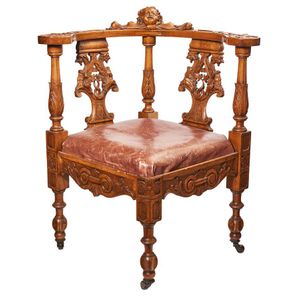19th Century Walnut Centre Table with Ornate Undercarriage
You must be a subscriber, and be logged in to view price and dealer details.
Subscribe Now to view actual auction price for this item
When you subscribe, you have the option of setting the currency in which to display prices to $Au, $US, $NZ or Stg.
- Turning - Any part of a piece of furniture that has been turned and shaped with chisels on a lathe. Turned sections include legs, columns, feet, finials, pedestals, stretchers, spindles etc. There have been many varieties and fashions over the centuries: baluster, melon, barley-sugar, bobbin, cotton-reel, rope-twist, and so on. Split turning implies a turned section that has been cut in half lengthwise and applied to a cabinet front as a false decorative support.
- Veneers - Veneers are thin sheets of well-figured timber that are glued under pressure to the surface of a cheaper timber for decorative effect, and then used in the making of carcase furniture.
Early veneers were saw-cut so were relatively thick, (up to 2 mm) but is was realised that saw cutting was wasteful, as timber to the equivilent of the thickness of the saw was lot on each cut.
A more efficient method was devised to slice the timber, either horizontally with a knife, or in a rotary lathe.
Flame veneer, commonly found in mahogany or cedar furniture, is cut from the junction of the branches and main trunk. So-called fiddleback veneers, where the grain is crossed by a series of pronounced darker lines, is usually cut from the outer sections of the tree trunk.
During the 17th and 18th centuries, and in much of the walnut marquetry furniture made during the latter part of the 19th century, the veneer was laid in quarters, each of the same grain, so that one half of the surface was the mirror image of the other.
The use of veneer allows many other decorative effects to be employed, including stringing, feather banding, cross banding, and inlaid decorative panels in the piece. The carcase over which veneer is laid is usually of cheaper timber such as pine, oak or, sometimes in Australia during the first half of the 19th century, red cedar.
The important thing to remember about veneers is that prior to about 1850 they were cut by hand, and were consequently quite thick - ranging up to about 2mm deep.
From the mid-19th century veneers were cut by machines and were almost wafer-thin. This is a critical point when trying to judge the approximate age of veneered furniture. - Quarter Veneer - In preparation for production of quarter-sawn veneer, the log is first quartered, meaning it's cut into four equal quarters. Each quarter of the log is then cut radially, resulting in boards with annual growth rings at approximately 90 degrees to the face of the board. Veneer Cutting: These boards are then sliced into thin veneer sheets using a veneer slicer. Quarter-sawn wood is known for its unique and attractive appearance and the growth rings have a distinctive figuring often referred to as ray fleck or medullary ray.
Quarter-sawn veneer is commonly used in furniture making. The unique grain pattern adds aesthetic appeal to pieces like cabinets, tables, and chairs. Decorative Panels: It is also used in the production of decorative panels for interior applications, such as wall panelling, doors, and trim. Some musical instrument makers use quarter-sawn veneer for the back and sides of instruments like guitars, providing both visual appeal and stability.
The distinctive grain pattern adds a unique and desirable look to finished products. Quarter-sawn wood, and consequently quarter-sawn veneer, can be more expensive than other types of wood due to the cutting process - Acanthus - A stylized leaf motif, one of the primary decorative elements of classical Greek and Roman architecture, derived from the genus of flowering plants in the family Acanthaceae, native to tropical and subtropical regions of the Mediterranean area. It is a common element in classical Greek and Roman design, and is often seen in Corinthian and Composite order columns and used as a decorative element in English, European and Australian furniture, particularly on the curve of a leg, and as decoration for a corbel.
This item has been included into following indexes:
Visually similar items

A square walnut centred table, Italian 18th/19th century. 84 cm high, 103 cm wide, 103 cm deep

A Continental Renaissance revival corner chair, 19th century, the curved back rest with applied putto head, beneath foliate carved splats, the seat covered in red leather upholstery, 70 cm high, 47 cm wide, 24 cm deep

A late 17th century oak joynt stool, the plank top with moulded edge over a carved frieze, raised on turned legs united by stretchers. 55 cm high.

A 17th century north European walnut and fruitwood Tric-Trac games table, the cover with central burr walnut veneer with feather banded border, lifts to reveal internal parquetry games board on turned legs with x-shaped stretcher, the cushion sided top unp
